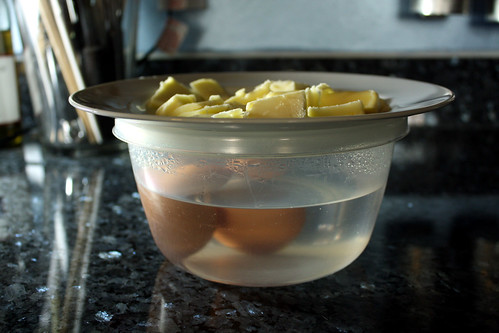
It’s common knowledge that many baking recipes want you to have your eggs and butter at room temperature before you begin. It’s also common knowledge that the craving for chocolate chip cookies or cupcakes is known to strike without enough warning to leave your ingredients out on the counter all day. Often, I’ll just plow ahead with chilled eggs and butter, but usually I regret it.
To solve that problem, I usually submerge my eggs in warm tap water until I’m ready for them and cut the butter into smaller pieces so that it warms faster. Here, I’ve made the process even more efficient. The heat from the warm water softens the butter without melting it completely, and the plate beneath the butter traps the heat of the water in to more thoroughly warm the eggs. By the time I started in on my cupcakes, the butter was perfectly soft and the eggs were just subtly warm to the touch. This is a bonus, because cracking warmish eggs feels far less cold and wet and icky than doing the same with ones right out of the fridge.

 Stumble Upon
Stumble Upon  Del.icio.us
Del.icio.us  Buzz
Buzz
That is so true! Cracking cold eggs does feel ickier..haha
Steph’s latest blog post: Elvis Presley’s Whipping Cream Pound Cake
I think it’s because cold makes our brains think things are wet even when they aren’t, so when something’s not just wet but gooey…ew!
I have seen other bloggers talking about warming the eggs, but what a great way to kill two birds with one stone, or should I say a warm water bird bath 🙂
Chef E’s latest blog post: Ume-boshi Cookies & Rice pudding
Haha, give two birds a spa treatment, then. 😀
Warming eggs before adding them to yeast bread dough always results in higher rise and softer/lighter texture. I didn’t know that until recently.
Great tips!
Leela’s latest blog post: Mâche Green Smoothies: Drink Your Salad!
I’m not sure I’d heard that one before! That makes sense, though, because one of the biggest reasons for it that I’ve heard is that you can whip more air into warm eggs than cool ones. Thanks for giving me another reason to remember to warm them up. 🙂
My chocolate chip cookies always turn out flat. Should my eggs and butter be room temature or cold? Or what else could be my problem?
That’s more likely a problem with the recipe…have you tried a few different ones? A few things you could try or look for in recipes that could decrease “spread”, according to my baking textbook:
– lower the sugar content
– use fine/baker’s sugar instead of coarse granulated sugar
– use less baking soda
– don’t cream the butter and sugar as much
– more flour (so as to have the structural support for the air incorporated by creaming)
– a higher oven temperature (at a lower temperature, there is more time for the butter to melt and the cookies to spread before they hit the temperature where they set)
– a stiffer batter (less liquid)
– higher gluten content in the flour
– use parchment paper or silicone baking mats instead of pan spray
That’s a lot of different variables to fuss with, though. You’re probably better off searching for recipes on blogs where the authors got the results your looking for, and then following their instructions. Good luck!
What would be the reason for my chocolate chip cookies always being flat?